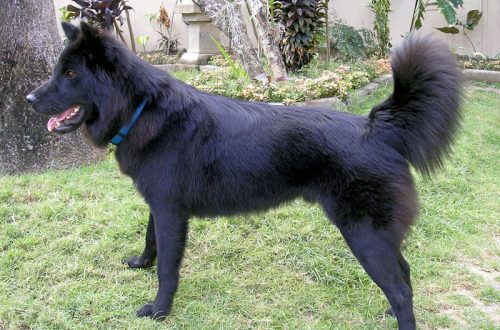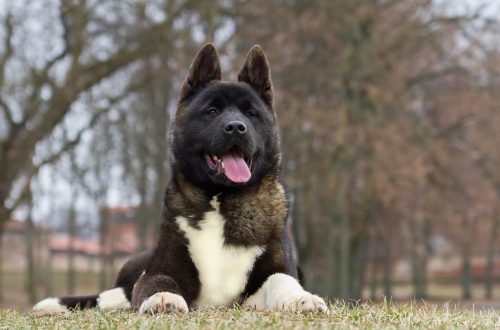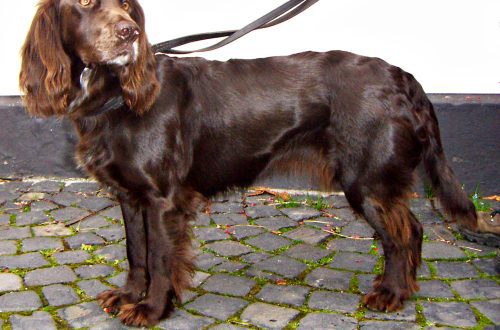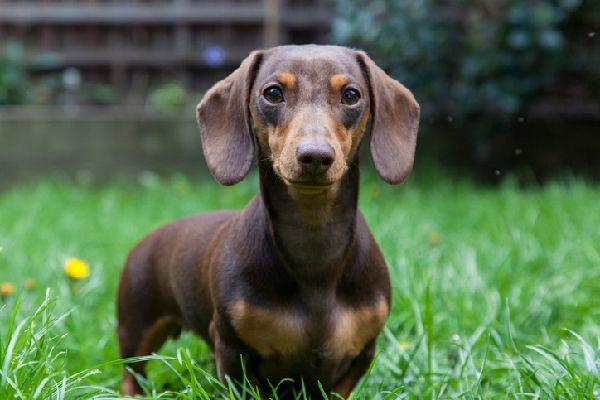
Miniature nga Dachshund
Other names: dwarf dachshund , mini dachshund
Dwarf dachshund (miniature dachshund, mini-dachshund) is the closest relative of the standard dachshund, which has the same exterior, but is inferior to it in size. In terms of size, the breed is an “intermediate link” between the standard and rabbit dachshunds.
Kaundan
- Characteristics of Miniature Dachshund
- Panguna nga mga gutlo
- History of the Miniature dachshund breed
- Video: Miniature dachshund
- Dachshund breed standard
- The nature of the miniature dachshund
- Education and training of Miniature Dachshund
- pagpangayam
- Pagpadayon ug pag-atiman
- Health and disease of pygmy dachshunds
- How to choose a puppy of Miniature Dachshund
- The price of a dachshund
Characteristics of Miniature Dachshund
| Nasod nga gigikanan | Germany |
| Ang gidak-on | mahinay |
| Pagtubo | mga 30 cm |
| Timbang | 4-5 kg |
| Age | 12-15 ka tuig |
| FCI breed nga grupo | Dili Giila |
Panguna nga mga gutlo
- In the body of a mini-dachshund hides a creature with a strong character and self-esteem, which is not averse to taking the place of a leader in your family.
- All pygmy dachshunds imagine themselves as superheroes and bravely rush to the defense of the owner, even when the threat is insignificant.
- The breed is sensitive to changes in temperature, so spending on a winter wardrobe for a mini-dachshund is inevitable.
- Small animals for a miniature dachshund are potential prey, but it is quite possible to teach a dog not to torture a cat and other representatives of the domestic fauna.
- The weak point of the breed is the spine, so any jumping is strictly contraindicated for dogs, and at junior age – independent descents and ascents of stairs, as well as lifting by the scruff of the neck.
- Miniature dachshund puppies are extremely playful, so hide expensive shoes, wires and household chemicals away, and get used to the fact that furniture and wallpaper will be tested “by the teeth”.
- The hunting instincts of the breed make its representatives perform feats even on walks: not a single dachshund will pass by a wormhole or mouse hole without exploring it.
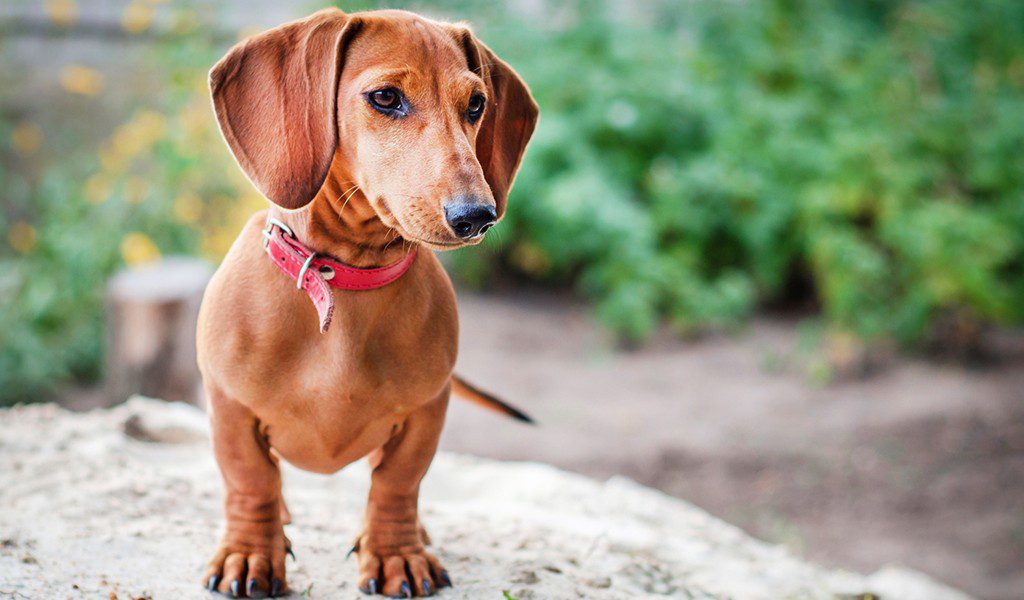
The dwarf dachshund is a clockwork “sausage”, always ready to save this world and its own owner to boot. Do not be deceived by the toy dimensions of a corpulent short-legged and do not try to consider a sofa sloth in it. A real mini-dachshund is an extremely curious pet and a gambling burrow inspector who is in a permanent search for suitable prey. At home, the dog is forced to reduce the degree of activity, so he takes out his hunting addictions on other small pets or toys.
History of the Miniature dachshund breed
The history of dwarf dachshunds can be traced back to the 16th century, when in the southern regions of Germany they were carried away by breeding burrowing dogs to catch badgers. True, some researchers consider the age of the breed more impressive, referring to the images of short-legged dogs found in the tombs of the pharaohs. Today, the relationship between the ancient Egyptian and German dachshunds remains unconfirmed, which does not prevent scientists from building the most incredible theories regarding the origin of burrowing breeds.
The original name of the dachshund is “daxhund”: from it. Dachs – “badger” and Hund – “dog”. However, over time, the compound word replaced the more convenient and shorter one – “dakel” (as an option – “tekel”), which is still called dachshunds in Germany. The progenitors of the breed are marriages – hounds with shortened, disproportionate legs. Through rigorous selection of sires, German breeders were able to produce extremely low-slung pets that were almost as reckless in hunting as marriages, but at the same time did not get stuck in badger burrows. By the 17th century, the clan of marriages had split into two branches – low hounds, who hunted in the usual way, and tekels, who specialized in working in holes.
As for the dwarf variety of the dachshund, it was born later than the standard one, and the breed was bred solely for practical purposes. The fact is that the descendants of marriages worked perfectly underground with foxes and badgers, but were large for rabbit holes. This prompted breeders to cross the standard dachshund with representatives of other miniature breeds. One of these pioneer breeders was F. Engelmann, who mated his wards with dwarf pinschers. The experiment was a failure, as the offspring born as a result had a thin skeleton and could not be used in hunting. After that, experts concentrated on intrabreed matings, selecting only the smallest individuals for them. It was in this way that the dwarf dachshund was first bred, and then even more miniature – the rabbit.
Dwarf dachshunds were brought to Russia in the 18th century, but only the big nobility could afford to own a short-legged dog. The hunting talents of the breed in domestic realities were also not used, so the animals led a well-fed and lazy life of decorative pets. Since the 19th century, the army of fans of dwarf dachshunds has not ceased to grow. The most famous fans of the breed: Queen Victoria, Napoleon Bonaparte, Princess Caroline of Monaco, Jacques Yves Cousteau.
Video: Miniature dachshund
Dachshund breed standard
Miniature, rabbit and standard dachshunds have one standard of appearance for three. This is explained by the fact that the breeds differ only in size and habits. As an example: the optimal growth limits for the dwarf dachshund are 30-35 cm, which is at least 5 cm less than the standard, but more than the rabbit variety. Otherwise, representatives of the dwarf branch are as well-fed as their relatives. An important proportional balance: the ratio of the height of the mini-dachshund at the withers to the length of the body must be at least 1:1.7 (1.8).
ulo
The contour of the head is elongated, but without sharpness. The eyebrows are clearly defined, the cranium is flattened, the stop is light, inconspicuous.
Mga igdulungog
The ears of the pygmy dachshund are distinguished by a high landing. The ear cloth is very mobile, moderately elongated in length.
Mata
All dachshunds have medium-sized, oval-shaped eyes, noticeably distant from each other. The look is clear, energetic, friendly, without suspicion. Colors of the iris approved by the standard: from red-brown to black-brown. Undesirable eye tones are whitish, partially or completely blue.
Ilong
The upper part of the nose is very narrow, elongated type. Lobe of normal size, developed.
Mga apapangig, ngabil, ngipon
Moderately strong jaws open easily, opening an elongated mouth. The corners of the lips with the mouth open are located almost on the line of the eyes. The lips themselves are without dampness, elastic, completely hiding the lower jaw. The bite is correct, scissor-shaped. The bow of the jaws is uniform, of good density. All teeth are welcome (42).
Ang liog
The moderately long neck of the miniature dachshund is set loose, relatively high, and also has a slightly convex scruff. The muscles of the neck are strong and developed, the skin is adjacent, well stretched.
frame
The Dwarf Dachshund is a long-bodied dog with a harmonious topline that slopes smoothly from the neck to the rump. The dog’s back is straight or slightly sloping with an elongated loin. For a wide long croup of an animal, a slight slope is characteristic. The sternum is impressive, protruding forward and forming small depressions on the sides. The shape of the chest is oval (when viewed from the front). The lower abdomen is well shaped.
mga limbs
The forelegs should be well muscled and straight, with proper angulation. The skeleton of the legs is strong, the contours are dry. The shoulder blades are characterized by a close fit to the chest. The shoulder blades themselves are elongated, located at an angle. The shoulders are movable, the same length as the shoulder blades and well adjacent to the area of the ribs. The forearms of a thoroughbred individual are short and as straight as possible, pasterns without tilt and plumb.
On the hind limbs, the articulation angles are clearly marked. The thigh part has a normal length and sufficiently powerful muscles. The stifle joints are large, with clear angles, the hocks are dry, very sinewy. The dachshund’s shins are short, forming a right angle with respect to the thigh, and the metatarsus is of sufficient length. The paws of the breed are rounded, with voluminous pads and collected fingers. The fifth fingers do not carry a functional load, but are not removed. The pygmy dachshund moves with smooth movements with a wide reach of the front legs, using the hind limbs for a powerful push.
Buntag
The tail of the pygmy dachshund continues the line of its back and has a fairly low landing. Let’s also allow a saber-shaped bend closer to the end of the tail.
Features of coat and colors of Miniature Dachshund
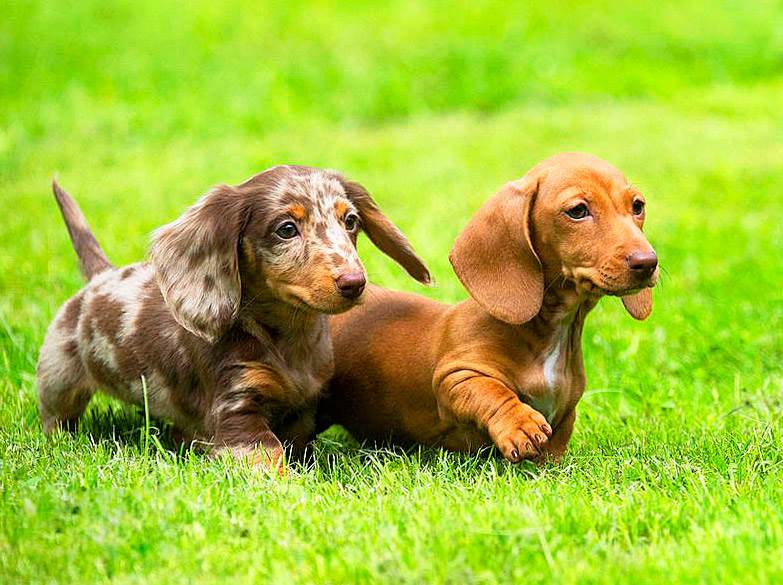





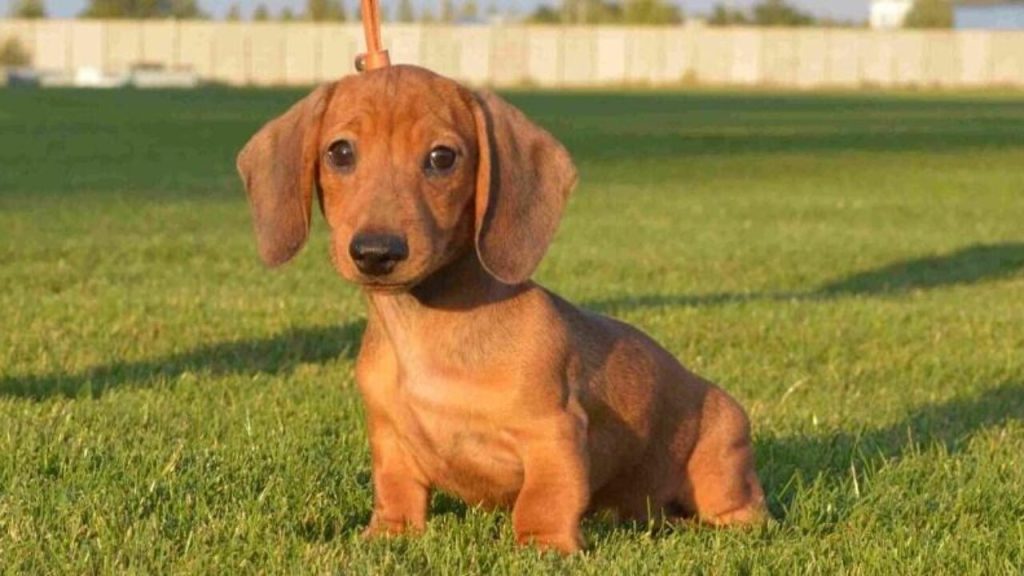



All mini-dachshunds are divided into smooth, hard and long-haired.
Dwarf dachshunds with a smooth coat are dogs covered with a very short shiny awn without bald spots and bald patches. Representatives of this variety are typical of one-color (red, red-red, fawn – solid or slightly diluted with black hair), two-color (black or brown and tan), as well as marble and brindle colors. It is undesirable, but the presence of single white marks on the body is acceptable. The earlobe and claws correspond to the tone of the coat, that is, in brown dachshunds they are colored brownish, in black and one-colored ones – black.
Wirehaired dwarf dachshunds have a wiry coat that fits well to the body. On the muzzle of dogs grow a beard, mustache and bushy eyebrows. The ears are covered with smoother and shorter hair than the body. Like smooth-haired relatives, wire-haired “dwarfs” have a solid, two-color and spotted suit. Colors from light boar to dark are welcome, as well as red.
Long-haired pygmy dachshunds are individuals with a straight double coat, elongated on the neck and lower body, as well as with feathering on the ears and back of the legs. Representatives of this variety are born with the same colors as smooth-haired dachshunds.
Pagdiskwalipika sa mga bisyo
Strict requirements are imposed on the exterior of dwarf dachshunds. In particular, the altered structure of the coat is considered a serious defect that affects the exhibition evaluation. Simply put, smooth-haired individuals should not have coarse hair, and wire-haired ones should not be too fluffy and soft. Animals with the following defects are not allowed to be exhibited in the ring:
- cowardly and aggressive behavior;
- deformed chest;
- non-standard closure of the jaws (overshot, crossbite, undershot bite);
- incorrect location in a row of lower fangs;
- incomplete set of teeth (partially or completely missing canines and incisors);
- goat feet;
- tail of irregular shape with creases;
- black wool without marks;
- white suit with or without tan marks;
- too freely located humerus and shoulder blades.
The nature of the miniature dachshund
Representatives of the miniature variety differ from standard dachshunds not only in size, but also in a more explosive temperament. Although the breed has never been bred for hunting in Russia, the working talents of the “dwarfs” have not atrophied, so they continue to use them wherever the opportunity presents itself. As an example: miniature dachshunds have a heightened protector instinct, which they do not hesitate to “turn on” several times a day.
If the pet urgently needs a discharge, and there is no suitable threat nearby, the brave short-legged one will come up with an enemy for himself, which he will immediately bark at. On walks, pygmy dachshunds remember their historical mission and willingly poke their nose into every hole. It is also a matter of honor for the breed to terrorize frogs, rodents and chicks that come across on the way, so do not regard such attacks as obstinacy and bad manners of the animal. Dwarf dachshunds cannot do otherwise.
In their youth, many representatives of the breed sin with destructive behavior. Basically, bursts of negative activity are typical for individuals who walk little and unproductively, often forced to be alone, so if your dachshund has started “repairs” in the apartment and removes wallpaper from the walls, there is reason to think. It is quite possible that it is not the pet that is to blame for this mess, but its reclusive lifestyle and your own laziness. As the animal grows older, the internal battery of the animal begins to work in a power saving mode. Take such changes calmly: the dog will not turn into a couch bumpkin anyway, it will just turn on the “alarm” a little less often.
Speaking of sofas: dwarf dachshunds are not averse to lying on them, but the breed likes games and active pastime more. Cunning “sausages” also establish contact with children for one or two, but with one caveat: the younger generation should not demonstrate their own superiority over the pet. In their hearts, most dwarf dachshunds consider themselves equal to the owner, leaving a lower rung of the hierarchical ladder for the rest of the family. Do not forget that all representatives of the breed are great artists when it comes to any benefits for them. Dachshunds who have received a scolding from the owner like to give their muzzles a mournful expression and put pressure on pity. Begging for an extraordinary walk or a treat, the dog also demonstrates miracles of cunning and ingenuity, which inexperienced owners often “bought” for.
Education and training of Miniature Dachshund
In training dachshunds, cynologists are advised to remove the “whip” away and be guided by the “carrot method”. This does not mean that the dog cannot be punished, just any negative significantly slows down the educational process. But the praise and delicious rewards of the breed, on the contrary, inspire feats. The main thing is not to rush to teach your pet everything at once. In the first months of life, it is generally not recommended to engage in dachshund training. It is better to focus on educational moments and the formation of a habit in the animal to observe the daily routine.
Once in a new home, a pygmy dachshund puppy must begin to live by the new rules. Slowly, but persistently, wean your baby from the habit of whining at night and asking to be in your room. Call your pet by name often so that he remembers it. From the very first days, determine a place for the puppy in the apartment and feed the little naughty strictly by the hour, which also disciplines perfectly.
In games, little dachshunds give free rein to instincts and bite, so be on the lookout and systematically eradicate this bad manner. As an example: in response to a bite, scream loudly or lightly pinch the baby’s nose with your fingers. Try not to succumb to the first reaction to the pain impulse and do not throw the dachshund to the side. This, firstly, is traumatic, and secondly, it embitters the pet.
Dwarf dachshunds get used to using the home toilet correctly quickly. It is enough to put the baby on the tray after sleep several times so that he understands what is expected of him. The habit of asking to go outside to relieve yourself is formed more slowly, so it is pointless to punish a ward who left a puddle on the floor for up to 4 months. Keep in mind that growing dachshunds do not yet have the ability to control the urge to urinate.
Primary dog training can begin at 3 months and is best outside the home. Of course, the puppy must first be introduced to the street, its smells and sounds. If you notice that outside the home walls the ward is afraid of sharp pops and cod, practice his courage. For example, pop balloons in front of your dog. Over time, the dachshund will stop responding to unpleasant sounds and will perceive them calmly.
pagpangayam
Hunting with a dwarf dachshund is not accepted, since the breed is too small to work on a burrowing animal, especially if we are not talking about cowardly young animals, but about foxes and badgers with experience. Of course, once in a hole, the dachshund will try its best to chase prey, only the beast is unlikely to be impressed by the size of its pursuer. Nevertheless, individual owners practice with the breed forays into the forest and field, but more for entertainment purposes than for practical ones. At hunting competitions, dwarf dachshunds periodically appear, having first-degree diplomas in fox and badger, however, it is important to understand that, basically, these are individuals working at baiting stations, and not in natural conditions.
It is extremely difficult to find a dwarf dachshund from hunting lines in Russia, but if you managed to acquire such a puppy, you can try your hand at baiting. However, first you need to go through the preparatory stages with the pet, that is, socialization, education and training for the commands “Sit!”, “Lie down!”, “Next!”, “Place!”, “Walk!”. Keep in mind that baiting is not hunting training, but just an attempt to awaken the getter and pursuer in the dog. You can take your pet to such classes no earlier than he is 6 months old. If the dachshund does not react to the artificial hole at the baiting station, this means that the working instinct has not awakened in it, and the animal just needs to be taken home to wait a month or two. Usually, fox cubs are used for the first feedings, since an adult animal can deal with a miniature and inexperienced dachshund in a tough way.
Pagpadayon ug pag-atiman
The place of a dwarf dachshund is in a house or apartment, but in no case on the street. By nature, the breed is very playful, so its representatives will have to buy toys often. A small life hack for owners: don’t give away all the toys at once, but change them periodically – the novelty effect works not only in the case of people, but also with animals. In winter, the breed freezes, so the duration of walks in frosty weather is reduced, and an inflated overall or knitted blanket is put on the animal before going outside.
Hats with ties will be a good protection from rain and wind. They can be sewn by yourself from thick knitwear or knitted. Calmly accept the fact that before the start of the heating season, the pet will actively try to get under your covers – the descendants of marriages love warmth and are always in search of a cozy refuge. The leash and collar for dwarf dachshunds should be light, because heavy ammunition additionally burdens the joints and spine.
Miniature Dachshund Hygiene and hair care
The breed does not require complex grooming, but even short-haired dachshunds need to be combed once a week. More often, this procedure is useless if you do not want to slow down hair growth. Daily grooming is required in autumn and spring, when the dog sheds. Usually, to remove dead hairs and street dust from the body of a short-haired dog, a rubber mitten or a piece of damp cloth is enough. Rough and long-haired individuals can be additionally combed with a brush – it perfectly collects fallen hair and massages the skin, stimulating the renewal of the coat.
The frequency of bathing your pet depends on the structure of his coat. Smooth-haired pygmy dachshunds are easy to dry clean, so they should be washed only when the animals are seriously soiled. Wirehaired and longhaired dogs (not show dogs) should take a bath at least once a month. By the way, keep in mind that after using shampoos and balms, the awn of the representatives of the last two varieties becomes softer and falls apart. Over time, the hair, of course, returns to normal, but if you have a show pet, it is better to wash only its paws, lower abdomen and muzzle on the eve of the show, and treat the rest of the body with dry shampoo.
Buy a nail clipper for decorative breeds and shorten the claws of the pygmy dachshund once a month. Check your eyes daily, removing the accumulated mucus and dust lumps in them with a clean, lint-free cloth soaked in an infusion of strong tea. The dog’s ears are examined once a week. If dirt and wax are found in the funnel, remove them with a hygienic lotion for dogs or special wipes for the ears.
Try to brush your dachshund’s teeth 2-3 times a week. For this purpose, buy a small brush and a special paste for dogs. If you have not been able to accustom the animal to this procedure, try an alternative technique – buying hard treats from the veins that work as abrasives.
Pagpakaon
Dwarf dachshunds are lovers of a lot and tasty food, which is explained by the high needs of the breed in animal protein. In this regard, dry pet food is selected with a high protein content (from 22%), and the proportion of plant foods in the diet (with natural feeding) is reduced to the required minimum. For owners who decide to feed their dog with natural products, it is important to rely on meat and offal. The best options are beef, horse meat, sinewy lamb, chicken and turkey, which are recommended to be lightly boiled or given raw. Once a week, a dwarf dachshund can be treated with boiled fish fillet and tendon bone.
Cereals – buckwheat, oatmeal, rice – are responsible for the carbohydrate component in the pet’s menu. They are given in the form of porridge or soup, mixed with meat and slightly salted. From vegetable food, apples, tomatoes, zucchini, carrots are useful for the breed. From time to time you can offer white cabbage, but only in boiled form. Potatoes are also not banned, but due to the high starch content, it is better to introduce them into the diet less often. An addition to the main menu can be curdled milk, rye crackers, a chicken egg. Overfeeding dwarf dachshunds is strongly discouraged, as the breed has a strong predisposition to obesity.
Adult dogs are fed 2 times a day. Elderly individuals are offered food 3 times a day, but the caloric content of the diet is reduced, since bulimia develops with age in animals. Feed for short-legged “pensioners” is also taken with a reduced protein content (from 15%). Puppies under the age of 3 months are fed 5 times, from 3 months to six months – 4 times. A fully grown dwarf dachshund is considered to be at 10 months, from the same age the animal is transferred to two meals a day.
Importante: both at a young and at an old age, a miniature dachshund needs dietary supplements with chondroprotectors, otherwise the animal has every chance of getting problems with the joints and spine.
Health and disease of pygmy dachshunds
Most diseases of the breed are the result of the physique of its representatives. For example, dwarf dachshunds often suffer from discopathy, in which the spine ceases to perform its shock-absorbing function. You can guess that an animal has problems by changes in behavior. Dogs with discopathy tend to move less and squeal when light pressure is applied to their back.
The breed also has such a rare pathology as black acanthosis. The disease is expressed in darkening and coarsening of the skin, as well as hair loss in the armpits and between the fingers. The disease is inherited and it is unrealistic to protect yourself from it, so all that can be done is to respond in time to changes in the exterior and contact a veterinarian.
In dwarf dachshunds aged 1 year and older, idiopathic epilepsy may manifest itself. Signs of an impending attack are impaired coordination, trembling, uncontrolled urination. Usually the problem is solved by the introduction of anticonvulsants. The only difficulty is that often injections have to be done on their own, since the disease can catch at the most inconvenient moment and away from the clinic.
How to choose a puppy of Miniature Dachshund
- Always ask the seller for a certificate of inspection of the litter – this will help you choose the healthiest animal.
- Try to get a puppy born in winter or early spring. After serving the prescribed period in quarantine, such kids will have time to catch warm summer days and strengthen immunity during walks.
- Take a close look at your baby’s back. In dwarf dachshunds, pathologies of the intervertebral discs occur, as a result of which humps grow on the backs of animals and saddle-shaped deflections form.
- See how the puppy moves. A slight clumsiness of movements is allowed, but obvious violations of coordination indicate problems with the bones and joints.
- When choosing black and tan individuals, pay attention to the saturation of the color. The more striking the contrast between the main suit and the tan spots, the better.
- The presence of a solid black color (without tan) in a dwarf dachshund puppy indicates that there are third-party non-purebred sires in his pedigree. Approximately the same can be said about the smooth-haired dachshunds who received a boar (spotted) color at birth.
The price of a dachshund
A miniature dachshund puppy with a RKF metric and a package of vaccinations costs 400 – 800$. Animals with minor exterior defects and imperfect pedigrees are sold for 150-250$.





